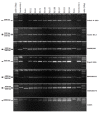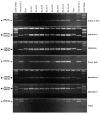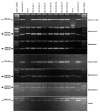Transfer of Stress Resilient QTLs and Panicle Traits into the Rice Variety, Reeta through Classical and Marker-Assisted Breeding Approaches
- PMID: 37445885
- PMCID: PMC10341874
- DOI: 10.3390/ijms241310708
Transfer of Stress Resilient QTLs and Panicle Traits into the Rice Variety, Reeta through Classical and Marker-Assisted Breeding Approaches
Abstract
Reeta is a popular late-maturing high-yielding rice variety recommended for cultivation in the eastern Indian states. The cultivar is highly sensitive to submergence stress. Phosphorus deficiency is an additional constraint for realizing high yield. The quantitative trait loci (QTLs), Sub1, for submergence and Pup1 for low phosphorus stress tolerance along with narrow-grained trait, GW5 were introgressed into the variety from the donor parent, Swarna-Sub1 through marker-assisted breeding. In addition, phenotypic selections for higher panicle weight, grain number, and spikelet fertility were performed in each segregating generation. Foreground selection detected the 3 target QTLs in 9, 8 and 7 progenies in the BC1F1, BC2F1, and BC3F1 generation, respectively. Recurrent parent's genome recovery was analyzed using 168 SSR polymorphic markers. The foreground analysis in 452 BC3F2 progenies showed five pyramided lines in homozygous condition for the target QTLs. No donor fragment drag was noticed in the Sub1 and GW5 QTLs carrier while a segmentwas observed in the Pup1 carrier chromosome. The developed lines were higher yielding, had submergence, and had low phosphorus stress-tolerance alongwith similar to the recipient parent in the studied morpho-quality traits. A promising pyramided line is released in the name of Reeta-Panidhan (CR Dhan 413) for the flood-prone areas of Odisha state.
Keywords: GW5; Pup1; Sub1; marker-assisted breeding; stress resilient; yield improvement.
Conflict of interest statement
The authors declare no conflict of interest.
Figures









References
-
- Sanghamitra P., Nanda N., Barik S.R., Sahoo S., Pandit E., Bastia R., Bagchi T.B., Pradhan S.K. Genetic structure and molecular markers-trait association for physiological traits related to seed vigour in rice. Plant Gene. 2021;28:100338. doi: 10.1016/j.plgene.2021.100338. - DOI
-
- Bastia R., Pandit E., Sanghamitra P., Barik S., Nayak D.K., Sahoo A., Moharana A., Meher J., Dash P.K., Raj R. Association Mapping for Quantitative Trait Loci Controlling Superoxide Dismutase, Flavonoids, Anthocyanins, Carotenoids, γ-Oryzanol and Antioxidant Activity in Rice. Agronomy. 2022;12:3036. doi: 10.3390/agronomy12123036. - DOI
-
- Food and Agriculture Organization of the United Nations . Rice Market Monitor. Volume 20. Food and Agriculture Organization of the United Nations; Rome, Italy: 2017. pp. 1–38.
-
- Dar M.H., Waza S.A., Shukla S., Zaidi N.W., Nayak S., Hossain M., Singh U.S. Drought tolerant rice for ensuring food security in Eastern India. Sustainability. 2020;12:2214. doi: 10.3390/su12062214. - DOI
MeSH terms
Substances
LinkOut - more resources
Full Text Sources

